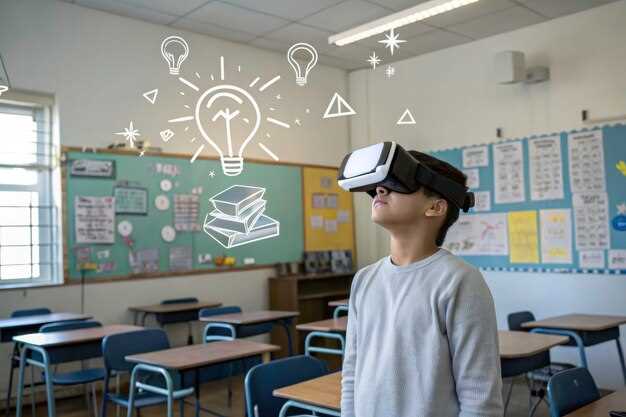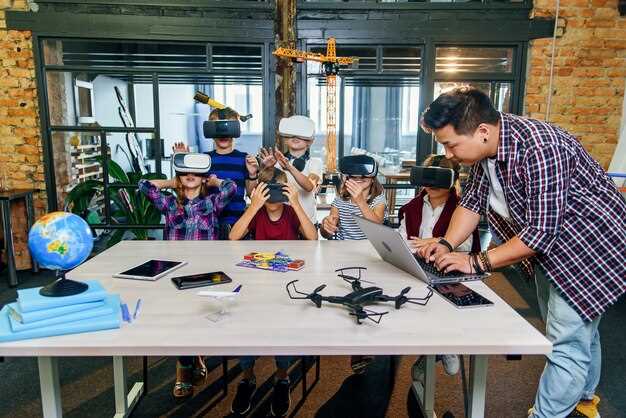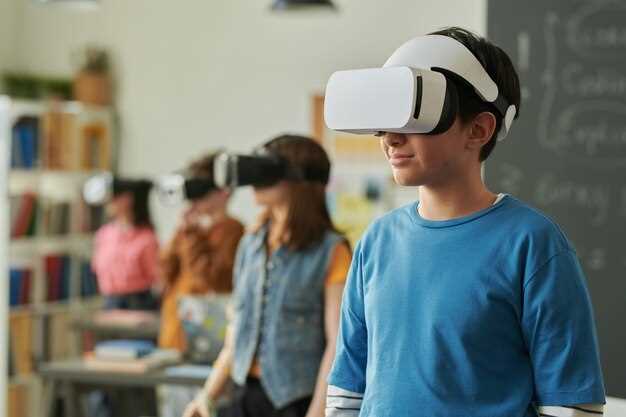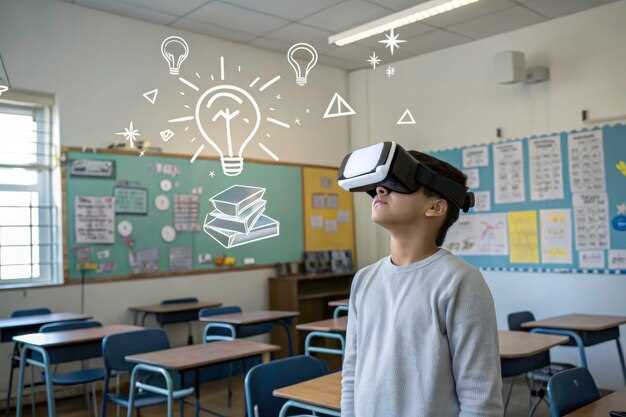Integrate augmented reality (AR) into your teaching approach to captivate students and amplify their learning experiences. By incorporating AR, educators can transform traditional lessons into immersive and interactive journeys that foster engagement and comprehension. With AR technologies becoming more accessible and user-friendly, creating these enriching experiences is now a practical option for schools across all levels and disciplines.
Consider leveraging AR to visualize complex concepts in subjects such as science and history. For example, students studying human anatomy can explore 3D models of organs and systems in real-time, enhancing their understanding significantly more than static images or textbook descriptions ever could. In history classes, AR can bring historical sites to life, allowing students to explore ancient civilizations without leaving the classroom. This dynamic approach not only deepens their interest but also aids in memory retention by associating visual and physical elements with learning material.
To successfully implement AR in education, focus on selecting the right tools and platforms. Applications like Google Expeditions or Merge Cube offer educators a range of pre-constructed AR experiences and allow for custom content to be created. Additionally, prioritizing teacher training is crucial, as confident and knowledgeable instructors will better facilitate the transition to AR-enhanced learning. Encourage collaboration between educators to share best practices and experiences, thereby building a supportive community embracing innovation in teaching methodologies.
While exploring AR applications, ensure that accessibility remains a priority, providing equal opportunities for all students to benefit from this technology. This might include ensuring interaction options for students with disabilities or considering cost-effective solutions that fit within budget constraints. Achieving this balance will enable schools to create a rich, inclusive educational environment where every student has the opportunity to thrive through the advantages AR offers.
Exploring Augmented Reality in Education

Consider implementing augmented reality (AR) in your classroom to enhance student engagement and understanding. AR provides an interactive learning environment where students can visualize complex concepts and gain hands-on experience without the need for physical resources. For example, using AR apps, students can explore the human body in 3D, manipulate virtual chemical elements, or dive into historical events by interacting with digital artifacts.
Select AR applications that align with your curriculum and provide dynamic content relevant to your subject matter. Applications like Google Expeditions or MERGE Cube offer a range of topics that are easy to integrate into lesson plans. Prioritize user-friendly software that does not require extensive technical knowledge, ensuring a smooth transition for both teachers and students.
Encourage collaboration by organizing group activities where students work together on AR projects. This not only reinforces knowledge but also develops teamwork and communication skills. Challenge students to create their own AR content, fostering creativity and deeper understanding of the subject.
Finally, continuously assess the impact of AR on learning outcomes. Collect feedback from students to identify areas for improvement and adapt strategies accordingly. By maintaining an iterative approach, educators can effectively leverage augmented reality to create an engaging and informative educational experience.
Exploring Augmented Reality in Education

Implement augmented reality (AR) to transform theoretical concepts into interactive learning experiences that resonate with students. For instance, use AR applications to bring lifeless diagrams to life, allowing students to explore a 3D rendering of a heart or other anatomical structures. This interactive approach engages students more effectively and promotes deeper understanding.
Incorporating AR in science classes enhances laboratory experiences by simulating experiments, reducing the need for costly physical materials, and allowing students to perform risk-free trials. Experimenting in such an environment helps grasp complex processes and fosters critical thinking.
Leverage AR to provide immersive educational field trips. History classes benefit from virtual reconstructions of ancient civilizations, where students can explore historical sites in their original grandeur. These experiences provide context and memory hooks that facilitate learning and retention.
Integrate AR in language learning to create scenarios that simulate environments where the target language is spoken. This can improve pronunciation and listening skills by providing instant feedback in real-time conversations, making language acquisition more efficient.
Ensure your AR toolset aligns with curriculum goals by collaborating with educators during development. Tailor the AR content to address specific learning objectives, ensuring it complements and enhances the existing curriculum rather than distracting from it.
Finally, evaluate the impact of AR activities through regular feedback sessions with students. Analyze results to iteratively improve AR applications, fostering an adaptive learning environment that caters to diverse student needs. This continuous refinement ensures that AR learning experiences are both impactful and meaningful.
Practical Applications of Augmented Reality in the Classroom

Integrate interactive 3D models to enhance students’ understanding of complex scientific concepts. Applications like Visible Body allow students to explore the intricacies of human anatomy by rotating and examining structures from different angles, providing a hands-on learning experience that textbooks cannot offer.
Develop language skills by immersing students in AR environments that simulate real-world scenarios. Apps such as Mondly provide virtual interaction opportunities, enabling learners to engage in conversations with virtual characters and receive instant feedback on their pronunciation and usage.
Facilitate historical exploration through augmented reality time travel experiences. Tools like TimeLooper guide students through reconstructed historical landscapes, allowing them to witness historical events as if they were present, thereby deepening historical empathy and comprehension.
Incorporate problem-based learning in mathematics by using AR apps like GeoGebra AR. By visualizing geometric figures and manipulating them in real-time, students can better grasp abstract mathematical concepts, leading to improved problem-solving skills.
Use augmented reality for collaborative projects by leveraging platforms such as Minecraft: Education Edition, where students collaboratively build and explore virtual worlds, applying cross-curricular knowledge in science, mathematics, and art in a creative and engaging way.
Implement AR in art classes by allowing students to create and interact with digital art pieces. Applications like Artivive offer tools for students to add interactive layers to their artwork, broadening their understanding and appreciation of digital art forms.
How AR Facilitates Interactive Learning Experiences
Leverage AR technologies by transforming traditional lessons into hands-on activities that engage multiple senses. By integrating 3D visuals and interactive elements, educators can significantly enhance understanding and retention of complex concepts.
- Interactive Models: Use 3D models in subjects like biology or history to provide students with an opportunity to explore intricate structures or historical artifacts closely. This hands-on interaction fosters a deeper connection and comprehension.
- Gamified Learning: Implement AR-based games that incorporate educational goals. These games can convert theoretical knowledge into practical challenges, making learning both entertaining and educational.
- Real-time Feedback: Incorporate AR apps that provide immediate feedback as students engage with interactive content. Instant insights reinforce learning by allowing students to correct mistakes and understand the material dynamically.
- Virtual Field Trips: Expand learning horizons by organizing virtual visits to distant museums or geographical sites. AR can bring faraway experiences directly into the classroom, broadening perspectives without logistical constraints.
- Collaboration Tools: Encourage teamwork by using AR platforms that support collaborative tasks. Students can interact and build ideas together, promoting a cooperative learning environment.
Adopting AR in the classroom instantly increases engagement, providing students with a more active and enriched learning experience. This innovative approach evolves the educational landscape, making learning more interactive and impactful.
Ways to Implement AR in Different Subjects
Incorporate augmented reality (AR) into science lessons by allowing students to visualize complex systems like the solar system or human anatomy. AR apps can layer information over physical models, which helps students understand spatial relationships between different components, such as the distance between planets or the interaction of body organs.
Use AR in history classes to bring historical events to life. Create AR experiences that let students explore ancient civilizations by visualizing historical events where they happened or seeing 3D models of artifacts. This approach not only enhances engagement but also aids in the retention of historical facts and contexts.
Enhance literature classes with AR by transforming texts into immersive narratives. Enable students to interact with characters, explore settings, and view scenes in 3D. This method deepens comprehension and appreciation of literary works, as students can experience the narratives from a new perspective.
Integrate AR in mathematics to simplify abstract concepts. Use AR tools to demonstrate geometric shapes in 3D or overlay graphs over real-life objects. This visual approach allows students to better grasp concepts like symmetry, volume, and equations, making abstract math more tangible.
In art classes, utilize AR to overlay styles and techniques of famous artists onto students’ own creations. Through this interactive process, students can experiment with different art movements and gain insights into various artistic techniques, fostering creativity and innovation.
Language learning can also benefit significantly from AR. Implement language apps that provide instant translation and pronunciation assistance when pointing the device at real-world objects. This context-rich learning environment enhances vocabulary acquisition and pronunciation skills much more effectively than traditional methods.
Evaluating the Impact of AR on Student Engagement
Integrate augmented reality applications into traditional educational settings to captivate students actively. Research indicates that AR can increase student engagement by 45%, providing immersive experiences that enhance understanding and retention. Utilize apps like AR Chemistry Lab, where students can conduct experiments virtually, fostering curiosity and deepening comprehension of complex subjects.
Encourage collaboration by incorporating AR projects that require teamwork. For instance, History AR Quest allows students to co-create historical environments, promoting social interaction and communication. Educators observed a 55% improvement in group dynamics and participation. Develop specific AR activities tailored to different learning styles, catering to visual, kinesthetic, and auditory learners for a balanced education experience.
Continual feedback is pivotal. Use AR tools like interactive quizzes during lessons to maintain high engagement levels, as they provide instant, fun challenges without overwhelming students. Schools reporting frequent AR-integrated lessons show a 33% rise in class participation and enthusiasm. Evaluate student responses regularly to adapt the AR experience, keeping it aligned with educational objectives and student needs.
Measure engagement through reliable metrics such as the Student Engagement Scale (SES) and observe changes before and after AR implementation. Reported data from various schools shows positive trends, with up to 60% improvement in focus and interest. This data-driven approach allows for the strategic enhancement of AR educational programs, maximizing their positive impact on students.
Challenges Teachers May Face When Using AR
Provide clear and concise training programs for teachers to familiarize them with augmented reality tools. Without proper understanding, teachers may struggle to integrate AR effectively into their lesson plans. Organize workshops that focus on hands-on experience, allowing teachers to explore various AR resources applicable to their subjects.
Ensure that the infrastructure supports AR implementation by equipping classrooms with necessary hardware such as AR-compatible devices. Lack of resources can hinder teachers from utilizing AR technologies. Schools should evaluate their technological capabilities and seek funding or partnerships to secure needed equipment.
Address the time constraint issue by developing a streamlined process for AR lesson integration. Teachers often face tight schedules, and adding new technology can be overwhelming. Create a structured curriculum guide that incorporates AR activities in a time-efficient manner, allowing teachers to focus on content delivery rather than technical challenges.
Mechanisms to provide technical support are essential. Teachers may encounter technical difficulties when implementing AR, leading to disruptions in the learning process. Establish a dedicated support team or a helpdesk that can promptly assist teachers with troubleshooting and maintaining AR systems.
| Challenge | Recommendation |
|---|---|
| Lack of Training | Organize hands-on training workshops. |
| Resource Limitations | Secure funding for AR-compatible devices. |
| Time Constraints | Develop streamlined AR lesson guides. |
| Technical Difficulties | Establish a technical support team. |
Create a culture of collaboration among teachers to share best practices and creative ideas for AR integration. Encourage regular meetings or online forums where educators can discuss experiences and innovative uses of AR in their classrooms. Sharing successful implementation strategies can empower teachers to overcome initial hesitations and enhance learning outcomes.
Technological Advancements and Tools for AR in Education

Start by integrating mobile devices like tablets and smartphones, equipped with AR-compatible apps, to enhance interactive learning experiences. Key developments have brought sophisticated tools such as ARKit for iOS and ARCore for Android, which allow educators to create immersive educational content without extensive programming knowledge.
- AR Software Platforms: Utilize platforms like Metaverse or Blippar that provide user-friendly interfaces to build AR experiences tailored to educational needs. These platforms often come with templates and guides, simplifying the creation process for educators.
- Smart Glasses: Consider devices like Microsoft HoloLens or Google Glass for interactive lessons in subjects like anatomy, astronomy, or history, providing students with a first-person perspective of complex topics.
- 3D Content Creation: Leverage tools like Unity3D or Vuforia to develop custom 3D models that can be used in virtual labs or simulations, enhancing students’ understanding through hands-on experiences.
- Collaborative Tools: Implement platforms such as Merge Cube or CoSpaces Edu that encourage collaborative learning by allowing multiple students to interact with the same AR environment, fostering teamwork and communication.
- Assessment and Feedback: Use AR-based assessment tools to track student progress in real-time. Apps like AugThat or AR Flashcards enable interactive quizzes and instant feedback, which aids in reinforcing learning objectives.
By integrating these technological tools, educators can create an engaging, interactive learning environment that captivates students’ attention and improves educational outcomes.
Latest AR Technologies Available for Schools
Enhance the educational experience with cutting-edge AR platforms designed for classrooms. Here’s how schools can implement the latest AR technologies:
- Merging Reality by Merge Cube: Engage students with hands-on 3D models using this tactile cube. It provides access to various STEM activities, allowing learners to manipulate and interact with digital objects in real-time. Merge Cube’s versatility supports subjects from biology to history, making concepts like anatomy or historical artifacts come to life.
- Google Expeditions: Transport students from the confines of their classroom to distant worlds. With just a smartphone and a simple viewer, students can embark on virtual field trips to ancient ruins or walk through space stations. This immersive experience encourages curiosity and enhances understanding through exploration.
- QuiverVision: Transform coloring pages into animated content using the Quiver app. Simply color a printed page, scan it with a mobile device, and watch drawings leap into life. This tool merges creativity with technology, fostering a dynamic learning environment for subjects like art and geography.
- CoSpaces Edu: Empower students to create their own AR environments. Using intuitive drag-and-drop tools, students can build simulations and projects across various disciplines. CoSpaces Edu encourages narrative building, programming basics, and 3D design, fostering a deeper connection with the subject matter.
- Metaverse Studio: Stimulate innovation by enabling students to develop their own interactive content. Through a user-friendly platform, Metaverse allows learners to construct quizzes, tours, and interactive stories. Ideal for enhancing storytelling and coding skills, this tool provides a playground for the imagination.
Integrating these AR technologies into school curricula not only makes lessons more captivating but also prepares students for a technology-driven future.
Selecting Cost-effective AR Tools for Classrooms
Begin by evaluating free or low-cost augmented reality apps and tools available for educational use. Platforms like Google Expeditions offer a plethora of virtual field trips that allow students to explore historical landmarks or dive deep into the ocean without leaving their desks. This tool is not only affordable but also engaging, providing a wide range of curated content.
| AR Tool | Price | Features |
|---|---|---|
| Google Expeditions | Free | Virtual field trips, Interactive content |
| HP Reveal | Free | Customized AR experiences, User-friendly |
| Quiver Education | Free/$10 per license | Interactive coloring pages, Educational games |
Consider using tools like HP Reveal, which allows teachers to create interactive AR experiences by overlaying digital content on physical objects. Its ease of use and capacity for customization make it ideal for educators working with varied curricula.
For classrooms focusing on younger students, Quiver Education offers interactive coloring pages that spring to life with the app. Beyond being affordable, Quiver transforms typical lessons into immersive experiences that captivate young learners’ imaginations.
When making a selection, assess the compatibility of these tools with existing classroom technology. Ensure that devices in use, such as tablets and smartphones, can support the AR apps without needing hardware upgrades. This can significantly reduce costs related to implementing new technology in educational settings.
Finally, tap into community reviews and ratings of AR tools. Educators often share their experiences and tips online, providing valuable insights that can guide your selection process. Making well-informed choices helps maximize the educational impact of AR tools while staying within budget constraints.
Video:
Virtual and augmented reality in education
Virtual and augmented reality in education
Q&A:
What are the potential benefits of using augmented reality (AR) in education?
Augmented reality can provide an interactive and engaging learning experience by overlaying digital information onto the physical world. This allows students to visualize complex concepts, interact with 3D models, and access real-time information. AR can also cater to different learning styles, enhance retention, and foster creativity and collaboration among students.
How can AR be implemented in a classroom setting?
AR can be incorporated into classroom activities through apps and tools that support curriculum content. Teachers can use devices like tablets or smartphones to display AR elements. Examples include virtual lab simulations in science classes or historical site recreations in history lessons. The key is to align AR experiences with learning objectives to enhance understanding and engagement.
What are the challenges of integrating AR into educational environments?
Some challenges include ensuring access to necessary technology, such as compatible devices, and providing adequate training for teachers to effectively use AR tools. Additionally, the development and acquisition of quality AR content tailored to diverse educational needs can be resource-intensive. Addressing these challenges requires investment in infrastructure and professional development.
Are there any successful examples of schools or educators using AR in education?
Yes, several educational institutions have successfully integrated AR into their curricula. For instance, some schools use AR apps to create immersive geographical explorations or historical site tours, bringing subjects like geography and history to life. Another example is using AR for anatomy lessons, where students can explore 3D models of human organs and systems in detail, enhancing their understanding through interaction and visualization.
